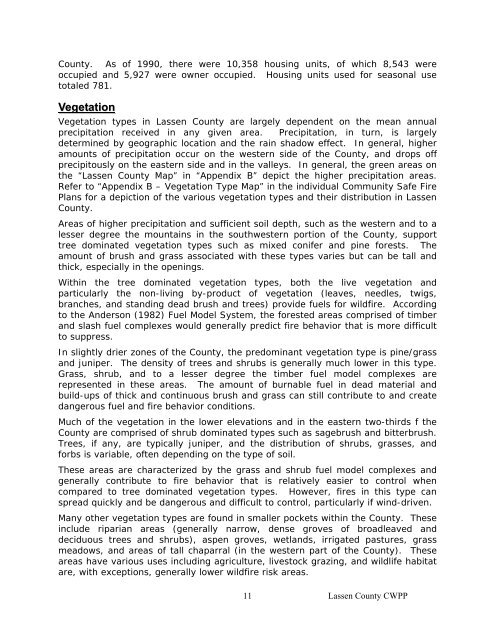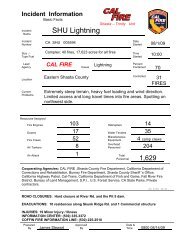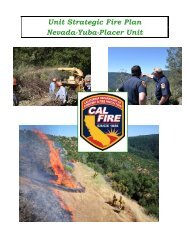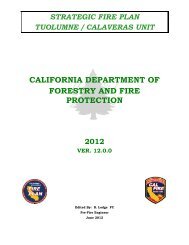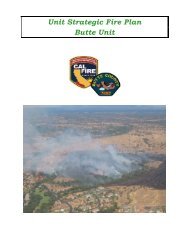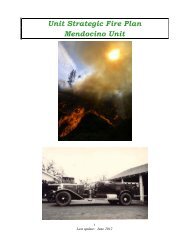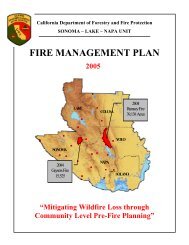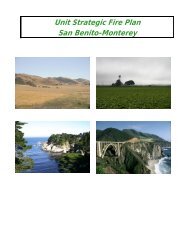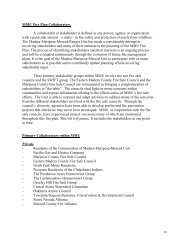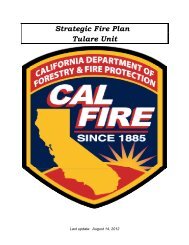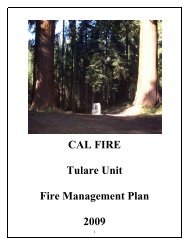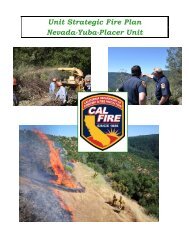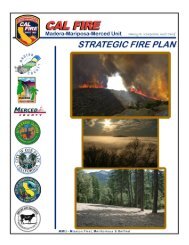Lassen – Modoc Unit - Board of Forestry and Fire Protection - State ...
Lassen – Modoc Unit - Board of Forestry and Fire Protection - State ...
Lassen – Modoc Unit - Board of Forestry and Fire Protection - State ...
You also want an ePaper? Increase the reach of your titles
YUMPU automatically turns print PDFs into web optimized ePapers that Google loves.
County. As <strong>of</strong> 1990, there were 10,358 housing units, <strong>of</strong> which 8,543 were<br />
occupied <strong>and</strong> 5,927 were owner occupied. Housing units used for seasonal use<br />
totaled 781.<br />
Vegetation<br />
Vegetation types in <strong>Lassen</strong> County are largely dependent on the mean annual<br />
precipitation received in any given area. Precipitation, in turn, is largely<br />
determined by geographic location <strong>and</strong> the rain shadow effect. In general, higher<br />
amounts <strong>of</strong> precipitation occur on the western side <strong>of</strong> the County, <strong>and</strong> drops <strong>of</strong>f<br />
precipitously on the eastern side <strong>and</strong> in the valleys. In general, the green areas on<br />
the “<strong>Lassen</strong> County Map” in “Appendix B” depict the higher precipitation areas.<br />
Refer to “Appendix B <strong>–</strong> Vegetation Type Map” in the individual Community Safe <strong>Fire</strong><br />
Plans for a depiction <strong>of</strong> the various vegetation types <strong>and</strong> their distribution in <strong>Lassen</strong><br />
County.<br />
Areas <strong>of</strong> higher precipitation <strong>and</strong> sufficient soil depth, such as the western <strong>and</strong> to a<br />
lesser degree the mountains in the southwestern portion <strong>of</strong> the County, support<br />
tree dominated vegetation types such as mixed conifer <strong>and</strong> pine forests. The<br />
amount <strong>of</strong> brush <strong>and</strong> grass associated with these types varies but can be tall <strong>and</strong><br />
thick, especially in the openings.<br />
Within the tree dominated vegetation types, both the live vegetation <strong>and</strong><br />
particularly the non-living by-product <strong>of</strong> vegetation (leaves, needles, twigs,<br />
branches, <strong>and</strong> st<strong>and</strong>ing dead brush <strong>and</strong> trees) provide fuels for wildfire. According<br />
to the Anderson (1982) Fuel Model System, the forested areas comprised <strong>of</strong> timber<br />
<strong>and</strong> slash fuel complexes would generally predict fire behavior that is more difficult<br />
to suppress.<br />
In slightly drier zones <strong>of</strong> the County, the predominant vegetation type is pine/grass<br />
<strong>and</strong> juniper. The density <strong>of</strong> trees <strong>and</strong> shrubs is generally much lower in this type.<br />
Grass, shrub, <strong>and</strong> to a lesser degree the timber fuel model complexes are<br />
represented in these areas. The amount <strong>of</strong> burnable fuel in dead material <strong>and</strong><br />
build-ups <strong>of</strong> thick <strong>and</strong> continuous brush <strong>and</strong> grass can still contribute to <strong>and</strong> create<br />
dangerous fuel <strong>and</strong> fire behavior conditions.<br />
Much <strong>of</strong> the vegetation in the lower elevations <strong>and</strong> in the eastern two-thirds f the<br />
County are comprised <strong>of</strong> shrub dominated types such as sagebrush <strong>and</strong> bitterbrush.<br />
Trees, if any, are typically juniper, <strong>and</strong> the distribution <strong>of</strong> shrubs, grasses, <strong>and</strong><br />
forbs is variable, <strong>of</strong>ten depending on the type <strong>of</strong> soil.<br />
These areas are characterized by the grass <strong>and</strong> shrub fuel model complexes <strong>and</strong><br />
generally contribute to fire behavior that is relatively easier to control when<br />
compared to tree dominated vegetation types. However, fires in this type can<br />
spread quickly <strong>and</strong> be dangerous <strong>and</strong> difficult to control, particularly if wind-driven.<br />
Many other vegetation types are found in smaller pockets within the County. These<br />
include riparian areas (generally narrow, dense groves <strong>of</strong> broadleaved <strong>and</strong><br />
deciduous trees <strong>and</strong> shrubs), aspen groves, wetl<strong>and</strong>s, irrigated pastures, grass<br />
meadows, <strong>and</strong> areas <strong>of</strong> tall chaparral (in the western part <strong>of</strong> the County). These<br />
areas have various uses including agriculture, livestock grazing, <strong>and</strong> wildlife habitat<br />
are, with exceptions, generally lower wildfire risk areas.<br />
11<br />
<strong>Lassen</strong> County CWPP


